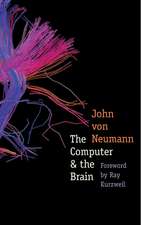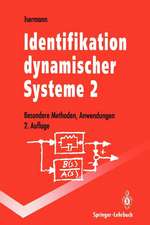Identification of Dynamic Systems
Autor Rolf Isermann, Marco Münchhofen Limba Engleză Hardback – 4 dec 2010
| Toate formatele și edițiile | Preț | Express |
|---|---|---|
| Paperback (1) | 605.20 lei 6-8 săpt. | |
| Springer Berlin, Heidelberg – 23 noi 2014 | 605.20 lei 6-8 săpt. | |
| Hardback (1) | 724.80 lei 6-8 săpt. | |
| Springer Berlin, Heidelberg – 4 dec 2010 | 724.80 lei 6-8 săpt. |
Preț: 724.80 lei
Preț vechi: 852.71 lei
-15% Nou
Puncte Express: 1087
Preț estimativ în valută:
138.73€ • 150.75$ • 116.61£
138.73€ • 150.75$ • 116.61£
Carte tipărită la comandă
Livrare economică 21 aprilie-05 mai
Preluare comenzi: 021 569.72.76
Specificații
ISBN-13: 9783540788782
ISBN-10: 3540788786
Pagini: 705
Ilustrații: XXV, 705 p. With Based on the book: Isermann: Identifikation dynamischer Systeme 1, 2. With online files/update.
Dimensiuni: 155 x 235 x 48 mm
Greutate: 1.19 kg
Ediția:2011
Editura: Springer Berlin, Heidelberg
Colecția Springer
Locul publicării:Berlin, Heidelberg, Germany
ISBN-10: 3540788786
Pagini: 705
Ilustrații: XXV, 705 p. With Based on the book: Isermann: Identifikation dynamischer Systeme 1, 2. With online files/update.
Dimensiuni: 155 x 235 x 48 mm
Greutate: 1.19 kg
Ediția:2011
Editura: Springer Berlin, Heidelberg
Colecția Springer
Locul publicării:Berlin, Heidelberg, Germany
Public țintă
ResearchCuprins
Introduction .- Mathematical Models of Linear Dynamic Systems and Stochastic Signals
Part I: Identification of Non-Parametric Models in the Frequency Domain - Continuous Time Signals
Part II: Identification with Non-Parametric Models - Continuous and Discrete Time
Part III: Identification with Parametric Models - Discrete Time Signals
Part IV: Identification with Parametric Models - Continuous Time Signals
PartV: Identification of Multi-Variable Systems
Part VI: Identification of Non-Linear Systems
Part VII: Miscellaneous Issues
Part VIII Applications
Part IX Appendix.
Part I: Identification of Non-Parametric Models in the Frequency Domain - Continuous Time Signals
Part II: Identification with Non-Parametric Models - Continuous and Discrete Time
Part III: Identification with Parametric Models - Discrete Time Signals
Part IV: Identification with Parametric Models - Continuous Time Signals
PartV: Identification of Multi-Variable Systems
Part VI: Identification of Non-Linear Systems
Part VII: Miscellaneous Issues
Part VIII Applications
Part IX Appendix.
Recenzii
From the reviews:
“The book being reviewed may serve as a useful entry guidebook to the assembling of mathematical models for actual physical systems, some of which are even pictured. The gamut of problems that the book’s material addresses is illustrated, over about seventy-five pages, with fifteen concrete examples … . One remarkable feature of the book is an effort made to help the reader in the process of choice of models and methods through overview tables and diagrams.” (A. F. Gualtierotti, Mathematical Reviews, Issue 2011 m)
“The book presents a broad spectrum of methods and approaches to dynamic system identification in a simple and unified manner. … Each chapter is completed with a set of problems to be solved by the reader and a list of references. The book can be recommended as a good overview of contemporary parametric system identification techniques.” (Zygmunt Hasiewicz, Zentralblatt MATH, Vol. 1230, 2012)
“The book being reviewed may serve as a useful entry guidebook to the assembling of mathematical models for actual physical systems, some of which are even pictured. The gamut of problems that the book’s material addresses is illustrated, over about seventy-five pages, with fifteen concrete examples … . One remarkable feature of the book is an effort made to help the reader in the process of choice of models and methods through overview tables and diagrams.” (A. F. Gualtierotti, Mathematical Reviews, Issue 2011 m)
“The book presents a broad spectrum of methods and approaches to dynamic system identification in a simple and unified manner. … Each chapter is completed with a set of problems to be solved by the reader and a list of references. The book can be recommended as a good overview of contemporary parametric system identification techniques.” (Zygmunt Hasiewicz, Zentralblatt MATH, Vol. 1230, 2012)
Notă biografică
Rolf Isermann studied Mechanical Engineering and obtained the Dr.-Ing. degree in 1965 from the University of Stuttgart. In 1968 he became "Privatdozent" for Automatic Control and since 1972 Professor in Control Engineering at the University of Stuttgart. From 1977-2006 he was Professor for Control Systems and Process Automation at the Institute of Automatic Control of the Darmstadt University of Technology. Since 2006 he is Professor emeritus and is head of the Research Group of Control Systems and Process Automation. R. Isermann received the Dr. h.c. (honoris causa) from L'Université Libre de Bruxelles and from the Polytechnic University in Bucharest. In 1996 he was awarded the “VDE-Ehrenring”, and in 2007 the “VDI-Ehrenmitglied”. The MIT Technology Review Magazine awarded him in 2003 to the Top Ten representatives of emerging Technologies for the field of Mechatronics. R. Isermann has published books on Modeling of Technical Processes, Process Identification, Digital Control Systems, Adaptive Control Systems, Mechatronic Systems, Fault Diagnosis Systems, Engine Control and Vehicle Drive Dynamics Control. Current research concentrates on the fields of identification and digital control of nonlinear systems, intelligent control and model-based methods of process fault diagnosis with applications to servo systems, fault-tolerant systems, combustion engines, automobiles and mechatronic systems. The research group on combustion engines works on multivariable engine modeling, HiL-simulation, combustion pressure control and fault diagnosis of both, CR-Diesel engines and FSI-gasoline engines. In the vehicle dynamics group present topics are parameter estimation for drive dynamics control, fault detection of sensors, suspensions, tires and brake systems and the development of collision avoidance systems with surrounding sensing and active braking and steering. The first books on system identification were published in German and date back to 1971, 1974, 1988, and1992. Since 1975, R. Isermann held several chair positions of IFAC-Technical Committees (International Federation of Automatic Control). In 1996, he was elected as Vice-President of IFAC until 2002. From 2002 to 2008, he was member of the IFAC-Council. R. Isermann organized several national and international conferences like the 5th IFAC Symposium on Identification in Darmstadt in 1979, the 10th IFAC-World-Congress in Munich 1987, the 1st IFAC-Symposium SAFEPROCESS, Baden-Baden, 1991 and the 1st IFAC-Conference on Mechatronic Systems, Darmstadt, 2000. He also organized the biannual VDI/VDE-Conference AUTOREG (control of vehicles and power trains) from 2002 to 2008.
Marco Muenchhof has studied electrical engineering at TU Darmstadt, Germany, and obtained a diploma (Dipl.-Ing.) and a doctoral degree (Dr.-Ing.) respectively. His doctoral thesis investigates fault detection and diagnosis methods for hydraulic servo axes. In addition to his studies in the field of electricalengineering, he holds a masters degree (M. S./SUNY) in mechanical and aerospace engineering from the State University of New York at Buffalo, USA. His research interests are in the fields of system identification, fault management for hydraulic/mechatronic systems, adaptive control, and control of flexible structures. For IFAC, the International Federation of Automatic Control, Marco Muenchhof had served as vice chair of the Technical Committee 4.1 (Components and Technologies for Control) in the triennium 2005-2008 and currently serves as chair for the triennium that ends in 2011. Also, he has been a member of International Program Committees of several conferences. Since 2006, he has been teaching the course “Identification of Dynamic Systems” at TU Darmstadt, which is a 14 week graduate level course on the topic of system identification. In the area of fault management, he has given semi-plenary lectures at the European Control Conference 2009 and the 7th IFAC Symposium on Fault Detection, Supervision and Safety of Technical Processes. Further information can be found on his homepage www.muenchhof.net.
Marco Muenchhof has studied electrical engineering at TU Darmstadt, Germany, and obtained a diploma (Dipl.-Ing.) and a doctoral degree (Dr.-Ing.) respectively. His doctoral thesis investigates fault detection and diagnosis methods for hydraulic servo axes. In addition to his studies in the field of electricalengineering, he holds a masters degree (M. S./SUNY) in mechanical and aerospace engineering from the State University of New York at Buffalo, USA. His research interests are in the fields of system identification, fault management for hydraulic/mechatronic systems, adaptive control, and control of flexible structures. For IFAC, the International Federation of Automatic Control, Marco Muenchhof had served as vice chair of the Technical Committee 4.1 (Components and Technologies for Control) in the triennium 2005-2008 and currently serves as chair for the triennium that ends in 2011. Also, he has been a member of International Program Committees of several conferences. Since 2006, he has been teaching the course “Identification of Dynamic Systems” at TU Darmstadt, which is a 14 week graduate level course on the topic of system identification. In the area of fault management, he has given semi-plenary lectures at the European Control Conference 2009 and the 7th IFAC Symposium on Fault Detection, Supervision and Safety of Technical Processes. Further information can be found on his homepage www.muenchhof.net.
Textul de pe ultima copertă
Precise dynamic models of processes are required for many applications, ranging from control engineering to the natural sciences and economics. Frequently, such precise models cannot be derived using theoretical considerations alone. Therefore, they must be determined experimentally. This book treats the determination of dynamic models based on measurements taken at the process, which is known as system identification or process identification. Both offline and online methods are presented, i.e. methods that post-process the measured data as well as methods that provide models during the measurement. The book is theory-oriented and application-oriented and most methods covered have been used successfully in practical applications for many different processes. Illustrative examples in this book with real measured data range from hydraulic and electric actuators, machine tools, industrial robots, pumps, vehicles to combustion engines. Real experimental data is also provided on the Springer webpage, allowing readers to gather their first experience with the methods presented in this book.
Among others, the book covers the following subjects: determination of the nonparametric frequency response, (fast) Fourier transform, correlation analysis, parameter estimation with a focus on the method of Least Squares and modifications, identification of time-variant processes, identification in closed-loop, identification of continuous time processes, and subspace methods. Some methods for nonlinear system identification are also considered, such as the Extended Kalman filter and neural networks. The different methods are compared by using a real three-mass oscillator process, a model of a drive train. For many identification methods, hints for the practical implementation and application are provided. The book is intended to meet the needs of students and practicing engineers working in research and development, design and manufacturing.
Among others, the book covers the following subjects: determination of the nonparametric frequency response, (fast) Fourier transform, correlation analysis, parameter estimation with a focus on the method of Least Squares and modifications, identification of time-variant processes, identification in closed-loop, identification of continuous time processes, and subspace methods. Some methods for nonlinear system identification are also considered, such as the Extended Kalman filter and neural networks. The different methods are compared by using a real three-mass oscillator process, a model of a drive train. For many identification methods, hints for the practical implementation and application are provided. The book is intended to meet the needs of students and practicing engineers working in research and development, design and manufacturing.
Caracteristici
The book presents different system identification methods, compares the different methods and discusses their application issues. Real experimental data can be downloaded, allowing to test the methods presented in the book. Includes supplementary material: sn.pub/extras























